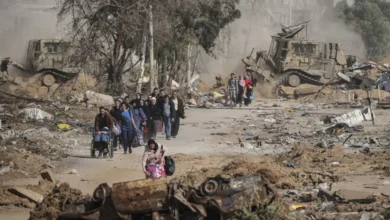The UAE’s Quiet Bargain: Pushing Syria’s New President Toward Normalization

Dark Box Exclusive
In recent weeks, the United Arab Emirates has intensified its efforts to shape Syria’s post-conflict political trajectory—not through public diplomacy or humanitarian aid, but through discreet high-level lobbying, massive investment pledges, and strategic pressure designed to steer Syria’s new president Ahmed al-Sharaa toward normalizing ties with Israel.
The UAE’s aim, according to well-placed regional sources speaking exclusively to Dark Box, is to engineer a post-Assad Syria that integrates seamlessly into a regional bloc built around normalization, anti-resistance alignment, and economic dependency on Gulf capital. At the center of this emerging architecture lies a deal: invest in rebuilding Syria’s economy in exchange for Sharaa’s gradual realignment toward Israel and the West.
Courting Sharaa: Investment for Influence
Since taking power after the fall of Bashar al-Assad in late 2024, President Sharaa has sought international legitimacy and financial support to stabilize a fragmented and war-torn nation. The UAE has seized this window of opportunity. In a series of private meetings, Emirati officials have reportedly offered Sharaa sweeping financial incentives, including investment packages in infrastructure, agriculture, telecoms, and energy—conditional upon him easing Syria toward normalization with Israel.
The UAE’s message, insiders say, is simple: Syria’s reintegration into the global economy—and Gulf financial systems—will remain blocked unless Sharaa aligns with the new regional order taking shape under Emirati leadership.
Normalization Through the Back Door
Sharaa’s visit to Washington and his upcoming participation in a U.S.-led coalition against Islamic State has been accompanied by quiet Emirati support behind the scenes. The UAE views this as an opportunity to push forward what it has long sought across the region: Arab regimes willing to trade Palestinian rights and national sovereignty for political survival and economic gain.
While Sharaa has not publicly endorsed normalization, Emirati envoys are working to prepare the ground for a phased process: beginning with discreet security deconfliction with Israel, followed by economic coordination, and ultimately diplomatic recognition. This mirrors the trajectory of the Abraham Accords, with the UAE acting as both architect and guarantor.
Sources close to the matter confirm that Emirati intelligence services have helped broker indirect contacts between Damascus and Tel Aviv through third-party European and Gulf mediators. The focus of these contacts includes reactivating the disengagement framework in the occupied Golan Heights, coordinating counter-insurgency efforts in southern Syria, and easing restrictions on cross-border commerce.
Why the UAE Needs Syria in the “New Middle East”
For the UAE, bringing Syria into its normalization fold is not just about Israel. It is about constructing a new regional axis that dilutes the influence of Iran and Turkey, contains grassroots political movements, and consolidates authoritarian governance as the acceptable regional model.
With Syria at the edge of reintegration, the UAE sees a unique opportunity to pull Damascus away from Tehran’s orbit. By investing heavily in reconstruction and state institutions, Abu Dhabi believes it can reshape Syria’s post-war identity—economically dependent on Gulf capital, politically distant from the resistance axis, and diplomatically compliant.
This strategy mirrors the UAE’s approach in Egypt, Sudan, and Libya, where financial assistance is used to mold the political trajectory of fragile states. In Syria’s case, the stakes are even higher: normalization with Israel would signal a complete reversal of decades of ideological opposition, offering a symbolic win for the normalization camp.
Israeli Encouragement, Emirati Execution
While Israel continues to occupy parts of southern Syria and maintains de facto control over areas like Mount Hermon, it has reportedly signaled cautious openness to a limited security agreement with Sharaa’s government—particularly if mediated by trusted Gulf partners. Israeli concerns remain focused on maintaining the military upper hand and preventing Iranian resurgence.
The UAE’s role here is pivotal. By offering itself as the guarantor of Sharaa’s “good behavior,” the Emiratis are positioning themselves as essential intermediaries between Syria and Israel, just as they did with Sudan during its normalization phase.
Meanwhile, pressure is mounting on the U.S. Congress to repeal or soften the Caesar sanctions, a key obstacle to Gulf investment. UAE-aligned lobbyists in Washington are reportedly pushing lawmakers to fast-track provisions within the 2026 Defense Act that would allow sanctioned regimes to receive “conditional exemptions” for stabilization efforts.
What’s at Stake for Syria?
For Sharaa, the equation is perilous. Emirati funding may provide the short-term cash injection his administration desperately needs—but the political cost could be catastrophic.
Any move toward normalization could spark unrest in Syria’s deeply scarred society, provoke opposition from pro-resistance elements, and alienate key regional allies such as Turkey and Iran. Moreover, it would validate the perception that Syria’s future is once again being shaped not by its people, but by foreign powers with strategic ambitions.
But Emirati officials are confident. They believe Sharaa—politically isolated, economically desperate, and keen to rebrand his Islamist roots—is open to a Faustian bargain.
Whether Syrians accept that bargain remains to be seen.




